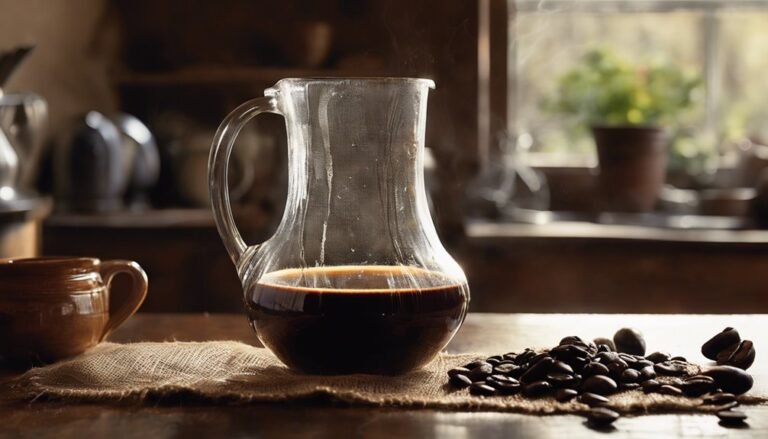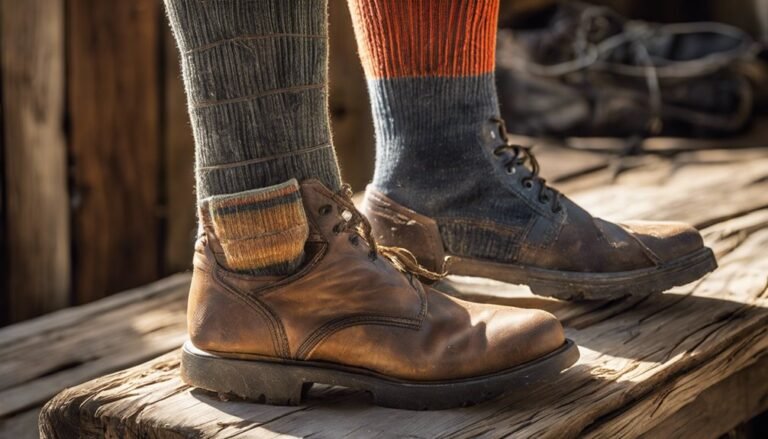Why Do Some Socks Make Feet Sweaty? Understanding Breathability
Imagine this: It's a warm summer day, and you're out enjoying a walk in the park. As you stroll along, you notice that your feet are becoming uncomfortably sweaty, and you wonder why.
Have you ever noticed how some socks seem to trap heat and moisture, leaving your feet feeling clammy? This can be attributed to the materials and construction of the socks you're wearing. For instance, socks made from cotton are notorious for retaining moisture, and their tight weaves can restrict airflow.
On the other hand, breathable fabrics like polyester and nylon, equipped with moisture-wicking technology, excel at maintaining dry feet by transferring sweat away from the skin.
Furthermore, the weave patterns of socks play a crucial role in breathability—looser weaves promote evaporation, helping to keep your feet cool.
Choosing breathable socks is essential for foot health, and there's plenty to explore when it comes to selecting the ideal socks for different activities.
The Science of Sock Fabric Breathability
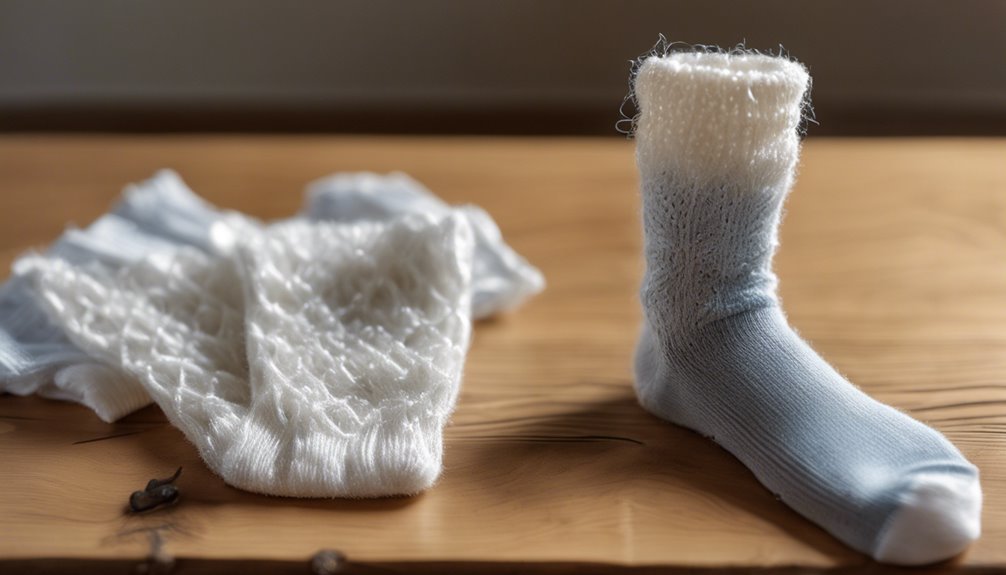
Although often overlooked, the science of sock fabric breathability is vital for maintaining foot health. You might not realize it, but the interplay between sock insulation and fabric thickness greatly impacts how your feet feel and perform. Breathable fabrics regulate moisture and thermal insulation, essential for preventing bacterial growth and odor. The fabric's thickness plays a pivotal role, too. Thicker fabrics may offer more insulation but can restrict airflow, trapping heat and moisture. Conversely, thinner fabrics generally allow better air circulation, promoting a cooler, drier environment for your feet. Understanding these dynamics empowers you to choose socks that enhance comfort and freedom, aligning with your lifestyle. Prioritizing breathability in your sock selection guarantees your feet remain healthy and comfortable.
Common Materials and Their Breathability Levels
When selecting socks, the material composition plays a critical role in determining their breathability levels. Understanding the differences in materials can greatly impact foot health and comfort. You'll find that cotton vs. polyester presents a notable contrast. Cotton, while soft and natural, absorbs moisture, which can lead to dampness and discomfort. Polyester, however, excels in moisture management, allowing for quicker drying and enhanced breathability.
Nylon offers advantages with its lightweight and durable nature, providing good ventilation while maintaining structure. Consider the following material qualities to enhance your freedom of choice:
- Cotton: Natural, but moisture-retentive.
- Polyester: Synthetic, promotes moisture evaporation.
- Nylon: Lightweight, offers structural integrity.
Choosing the right material guarantees superior airflow, reducing the risk of sweaty feet and promoting overall comfort.
How Moisture-Wicking Technology Works
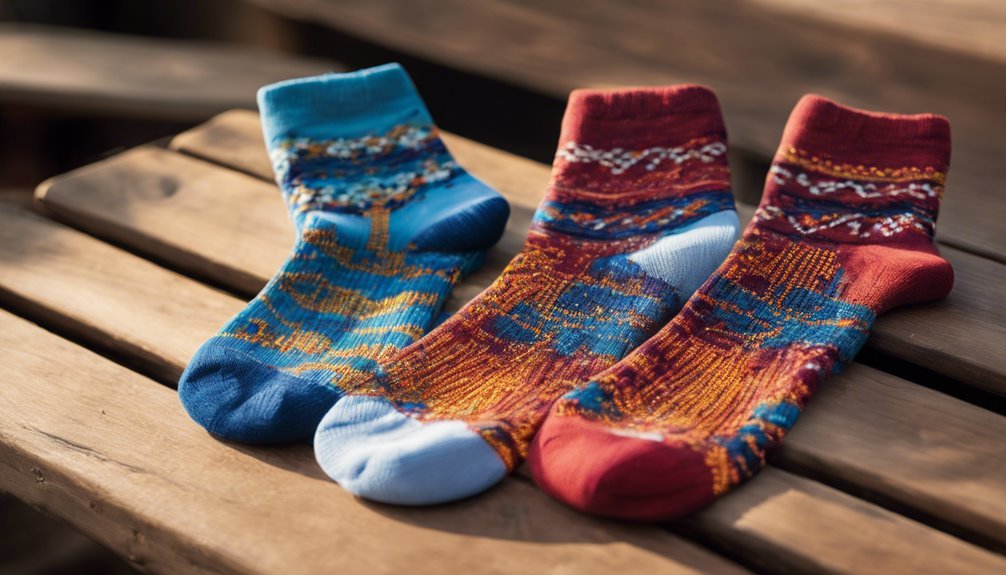
Moisture-wicking technology, an essential development in textile engineering, enhances sock performance by efficiently managing perspiration. This innovation focuses on moisture management by transferring sweat from your skin to the sock's outer surface, where it evaporates more easily. The technology employs hydrophobic fibers, which repel moisture, ensuring your feet remain dry and comfortable. Thermal regulation is also a key benefit, as these fibers help maintain an ideal temperature, preventing overheating. By allowing air circulation, moisture-wicking socks reduce the risk of blisters and fungal infections, promoting foot health. You gain the freedom to engage in activities without discomfort or dampness. Ultimately, moisture-wicking technology supports an active lifestyle, ensuring your feet stay dry, cool, and ready for any adventure.
Impact of Weave Patterns on Airflow
Understanding the impact of weave patterns on airflow is essential for enhancing sock ventilation and, consequently, foot health. You'll find that weave density directly influences the amount of airflow resistance within the sock fabric. A tighter weave density can lead to increased airflow resistance, trapping heat and moisture against your skin. Conversely, a looser weave facilitates better airflow, promoting evaporation and keeping feet cool.
Consider these factors:
- Weave Density: Higher density means reduced airflow and increased moisture retention.
- Airflow Resistance: Impacts how effectively foot sweat is managed.
- Material Interaction: Weave patterns must align with fiber properties for maximum breathability.
Choosing Socks for Different Activities and Environments
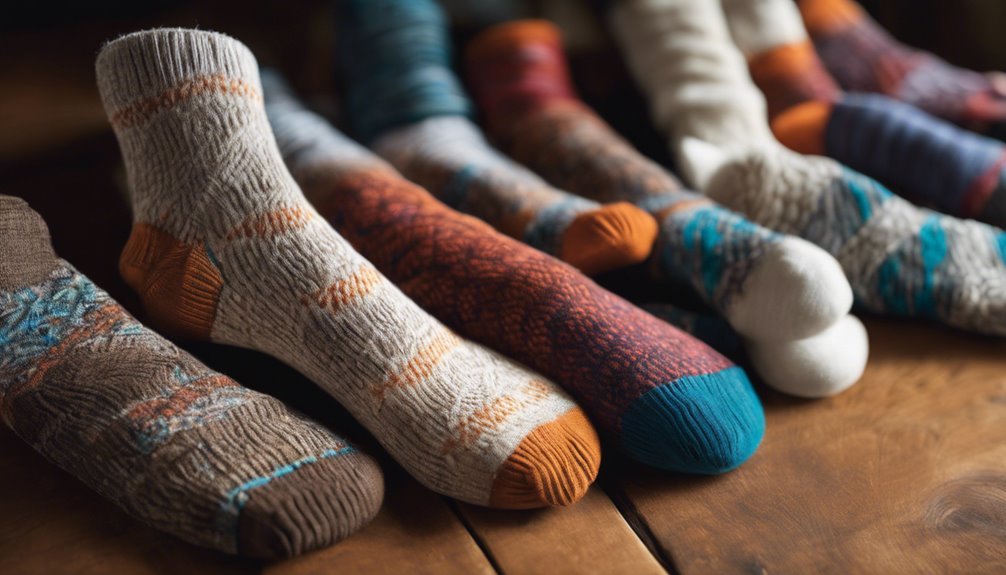
After examining the influence of weave patterns on airflow, selecting the right socks for various activities and environments becomes a key consideration for ideal foot health. Hiking socks, designed with thicker fibers, offer enhanced cushioning and temperature regulation, vital for rugged terrains. Athletic socks prioritize breathability and moisture-wicking properties, allowing feet to stay dry during intense physical exertion. Dress socks, often thinner, focus on aesthetics while maintaining sufficient airflow for comfort in formal settings. For everyday wear, casual socks strike a balance between comfort and breathability, adapting to diverse temperatures and activities. Understanding sock thickness and fiber composition is essential for optimizing comfort and freedom, ensuring your feet remain dry and healthy regardless of activity or environmental conditions.
Tips for Maintaining Sock Freshness
To guarantee sock freshness, you'll need to employ proper washing techniques that prevent bacterial buildup, which is essential for foot health. Use gentle cycles and temperature settings that align with fabric care instructions, as improper washing can compromise breathability and lead to odor retention. Additionally, organize and store your socks in a dry, well-ventilated space to inhibit moisture accumulation and maintain fiber integrity.
Proper Washing Techniques
While it's often overlooked, the proper washing of socks is essential to maintaining foot health and guaranteeing their longevity. Effective sock care involves understanding the interplay between fabric integrity and hygiene. Adhering to a preferred washing frequency prevents the buildup of sweat and bacteria, which can exacerbate foot perspiration and odor issues.
To maximize freshness and breathability, consider these expert recommendations:
- Choose a mild detergent: Harsh chemicals can degrade fibers, reducing moisture-wicking capabilities.
- Opt for cold water wash: This minimizes shrinkage and preserves elastic components, enhancing fit and comfort.
- Air dry when possible: High heat can distort fabric structure, affecting breathability and longevity.
Incorporating these techniques into your routine guarantees your socks remain allies in your quest for freedom and foot comfort.
Storage and Organization
Even though it might seem trivial, how you store and organize your socks plays an essential role in maintaining their freshness and functionality. Utilizing effective organizing techniques in your sock drawer can enhance breathability and foot health. Start by ensuring your sock drawer is clean and dry, as moisture can compromise material integrity, fostering microbial growth. Roll socks instead of folding, allowing air circulation and preventing fabric compression. Segregate based on material—cotton, wool, synthetics—to facilitate selection for specific activities, enhancing comfort and minimizing sweat. Use drawer dividers for easy access and to prevent overcrowding, which stifles airflow. By prioritizing an organized sock drawer, you're not just maintaining sock freshness, but empowering your feet with freedom and excellent foot health.
Frequently Asked Questions
Do Socks Affect Foot Odor and How?
Socks definitely affect foot odor. When you wear socks with poor sock composition, they trap moisture, causing bacteria growth. Opt for socks with moisture-wicking properties to enhance foot health, ensuring freedom from unpleasant odors and discomfort.
Can Sock Color Influence Foot Temperature?
Did you know dark socks can absorb up to 90% of sunlight? This color absorption increases sock insulation, potentially raising foot temperature. Choosing lighter colors can enhance comfort, especially if you value freedom and ideal foot health.
Are There Socks Designed for People With Hyperhidrosis?
You'll find socks specifically designed for hyperhidrosis, featuring moisture-wicking fabrics and advanced cooling technology. These innovations focus on foot health, ensuring ideal dryness and reducing discomfort, giving you the freedom to stay active without sweaty feet concerns.
What Historical Materials Were Used for Breathable Socks?
You're curious about historical materials for breathable socks. Cotton's history dates back centuries, valued for its lightness and moisture-wicking. Wool's properties, like natural insulation and moisture regulation, have supported foot health, offering freedom from discomfort.
How Do Sock Sizes Impact Foot Comfort?
When sock sizes don't fit properly, moisture management suffers, and foot health is compromised. Ill-fitting socks cause friction, reducing effectiveness of sock materials designed for breathability. Proper sizes guarantee comfort, allowing freedom and ideal moisture control.


